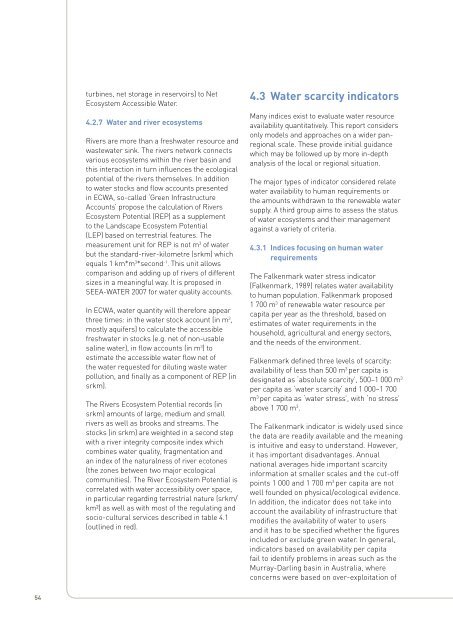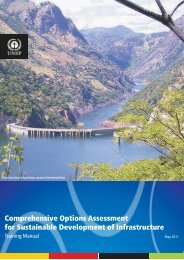MEASURING WATER USE IN A GREEN ECONOMY - UNEP
MEASURING WATER USE IN A GREEN ECONOMY - UNEP
MEASURING WATER USE IN A GREEN ECONOMY - UNEP
You also want an ePaper? Increase the reach of your titles
YUMPU automatically turns print PDFs into web optimized ePapers that Google loves.
turbines, net storage in reservoirs) to Net<br />
Ecosystem Accessible Water.<br />
4.2.7 Water and river ecosystems<br />
Rivers are more than a freshwater resource and<br />
wastewater sink. The rivers network connects<br />
various ecosystems within the river basin and<br />
this interaction in turn influences the ecological<br />
potential of the rivers themselves. In addition<br />
to water stocks and flow accounts presented<br />
in ECWA, so-called ‘Green Infrastructure<br />
Accounts’ propose the calculation of Rivers<br />
Ecosystem Potential (REP) as a supplement<br />
to the Landscape Ecosystem Potential<br />
(LEP) based on terrestrial features. The<br />
measurement unit for REP is not m 3 of water<br />
but the standard-river-kilometre (srkm) which<br />
equals 1 km*m 3 *second -1 . This unit allows<br />
comparison and adding up of rivers of different<br />
sizes in a meaningful way. It is proposed in<br />
SEEA-<strong>WATER</strong> 2007 for water quality accounts.<br />
In ECWA, water quantity will therefore appear<br />
three times: in the water stock account (in m 3 ,<br />
mostly aquifers) to calculate the accessible<br />
freshwater in stocks (e.g. net of non-usable<br />
saline water), in flow accounts (in m 3 ) to<br />
estimate the accessible water flow net of<br />
the water requested for diluting waste water<br />
pollution, and finally as a component of REP (in<br />
srkm).<br />
The Rivers Ecosystem Potential records (in<br />
srkm) amounts of large, medium and small<br />
rivers as well as brooks and streams. The<br />
stocks (in srkm) are weighted in a second step<br />
with a river integrity composite index which<br />
combines water quality, fragmentation and<br />
an index of the naturalness of river ecotones<br />
(the zones between two major ecological<br />
communities). The River Ecosystem Potential is<br />
correlated with water accessibility over space,<br />
in particular regarding terrestrial nature (srkm/<br />
km²) as well as with most of the regulating and<br />
socio-cultural services described in table 4.1<br />
(outlined in red).<br />
4.3 Water scarcity indicators<br />
Many indices exist to evaluate water resource<br />
availability quantitatively. This report considers<br />
only models and approaches on a wider panregional<br />
scale. These provide initial guidance<br />
which may be followed up by more in-depth<br />
analysis of the local or regional situation.<br />
The major types of indicator considered relate<br />
water availability to human requirements or<br />
the amounts withdrawn to the renewable water<br />
supply. A third group aims to assess the status<br />
of water ecosystems and their management<br />
against a variety of criteria.<br />
4.3.1 Indices focusing on human water<br />
requirements<br />
The Falkenmark water stress indicator<br />
(Falkenmark, 1989) relates water availability<br />
to human population. Falkenmark proposed<br />
1 700 m 3 of renewable water resource per<br />
capita per year as the threshold, based on<br />
estimates of water requirements in the<br />
household, agricultural and energy sectors,<br />
and the needs of the environment.<br />
Falkenmark defined three levels of scarcity:<br />
availability of less than 500 m 3 per capita is<br />
designated as ‘absolute scarcity’, 500–1 000 m 3<br />
per capita as ‘water scarcity’ and 1 000–1 700<br />
m 3 per capita as ‘water stress’, with ‘no stress’<br />
above 1 700 m 3 .<br />
The Falkenmark indicator is widely used since<br />
the data are readily available and the meaning<br />
is intuitive and easy to understand. However,<br />
it has important disadvantages. Annual<br />
national averages hide important scarcity<br />
information at smaller scales and the cut-off<br />
points 1 000 and 1 700 m 3 per capita are not<br />
well founded on physical/ecological evidence.<br />
In addition, the indicator does not take into<br />
account the availability of infrastructure that<br />
modifies the availability of water to users<br />
and it has to be specified whether the figures<br />
included or exclude green water. In general,<br />
indicators based on availability per capita<br />
fail to identify problems in areas such as the<br />
Murray-Darling basin in Australia, where<br />
concerns were based on over-exploitation of<br />
54

















